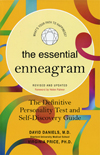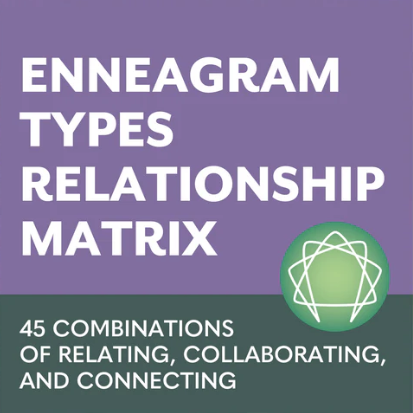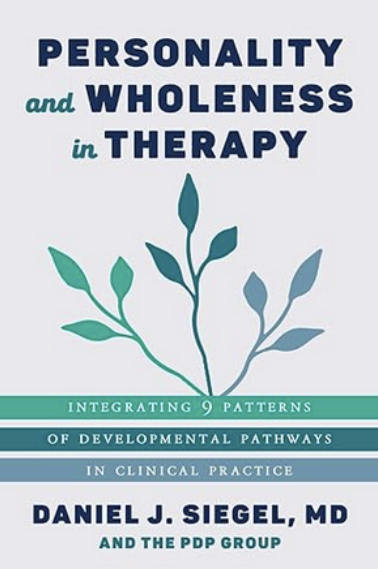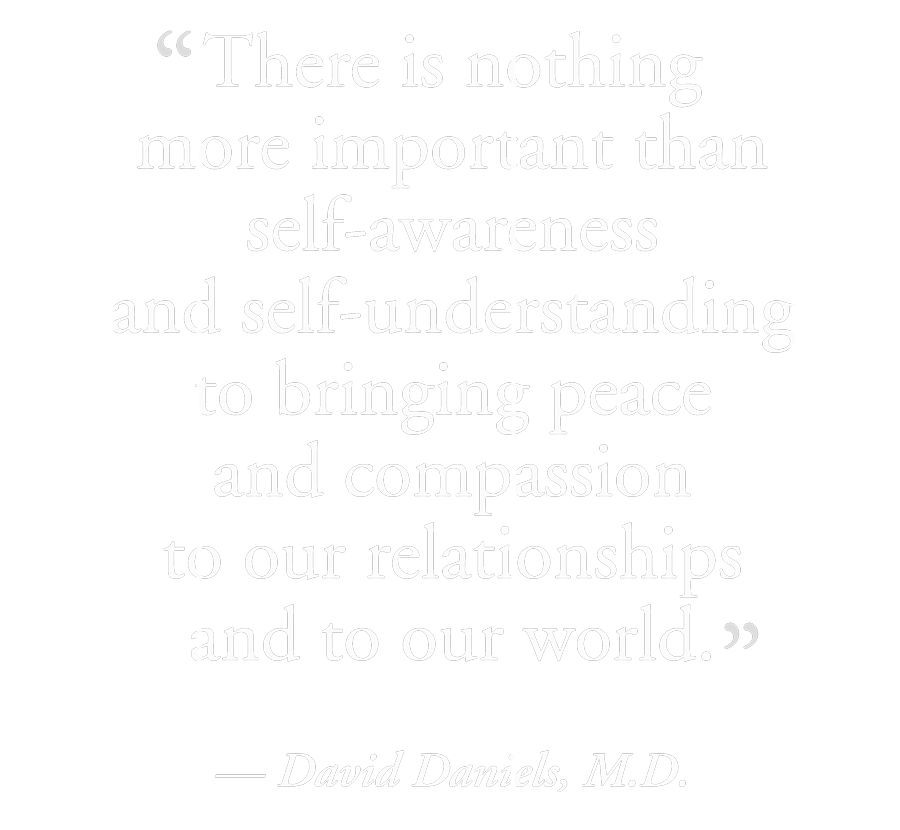Enneagram Test Options: Discover Your Enneagram Type
There are two effective options available in order to figure out our driving Enneagram type and begin our path of development. We often recommend both taking the actual paragraph-based Essential Enneagram Test as well as taking advantage of an in-person Enneagram Typing Interview with a trained Enneagram specialist.
 1. TAKE THE ESSENTIAL ENNEAGRAM TEST
1. TAKE THE ESSENTIAL ENNEAGRAM TEST
This is the first scientifically validated test available today and uses the paragraph Enneagram typing method. This test was developed by David N. Daniels, M.D. and psychologist Virginia Price, Ph.D., both of Stanford University.
PAPERBACK (BOOK) TEST | $7.99 – Take the Essential Enneagram Test, by ordering the book, THE ESSENTIAL ENNEAGRAM on Amazon.com >>
ONLINE TEST | $10.00 – Take the Essential Enneagram Test Online on The Narrative Enneagram (TNE) website >>
 2. SIGN UP FOR AN ENNEAGRAM TYPING INTERVIEW
2. SIGN UP FOR AN ENNEAGRAM TYPING INTERVIEW
TYPING-INTERVIEW | $100.00 – Sign-up for a 75+-minute Self-discovery, Enneagram Typing Interview with Certified Enneagram Teacher and Coach, Suzanne Dion.
Contact Suzanne Dion via email for questions, or call 1 831 359 0332.
Typing interview is conducted online via Zoom or Skype for FaceTime.
The Typing Interview is recommended in conjunction with the Essential Enneagram Test.
Using the Essential Enneagram Test,
Created by David N. Daniels, M.D.
Highlights of the Essential Enneagram Test
Very user-friendly
Reliable and scientifically validated by nearly a thousand individuals using a rigorous process based on external criteria not another test
Features a process of self-discovery as we can not be reliably typed from the outside
![]() WHERE TO TAKE THE ESSENTIAL ENNEAGRAM TEST: You can take The Essential Enneagram Paragraph Test online at narrativeenneagram.org, or you can purchase a copy of The Essential Enneagram, which contains the test itself.
WHERE TO TAKE THE ESSENTIAL ENNEAGRAM TEST: You can take The Essential Enneagram Paragraph Test online at narrativeenneagram.org, or you can purchase a copy of The Essential Enneagram, which contains the test itself.
Discovering Your Personality Type
David Daniels developed The Essential Enneagram Test as a simple and accurate way for individuals to discover their Enneagram personality type and as a guide for further personal, professional, and spiritual development. As you undergo this process, remember, we are all human beings, a species that employs a pattern or “type” as an adaptive strategy. It’s purpose is survival and to hopefully have a satisfying survival experience. Yet our type structure, as much as its designed for our survival can also become a hindrance in that it can limit our experience of our lives, well-being, and relationships, all of which causes distress and suffering.
The Essential Enneagram Test consists not of a series of questions, but of nine short, user-friendly paragraphs that describe the fundamentals of each of the personality types. As you read each paragraph and undergo your own discovery process, you will also inadvertently be exposed to all nine of the types. To take the test, simply read each of the paragraph descriptions, and choose the three that seem to fit you the best. Next, put the three selected paragraphs in order of most similar to you to the least similar to you, beginning with the one that is the most like you.
Following the instructions in The Essential Enneagram, you’ll be taken on an adventure in self-discovery. You’ll be guided through basic terminology relevant to the Enneagram. You will step-by-step arrive at the determination of your personality type, a comprehensive description of your type, the key discriminators differentiating each type from every other type, and the discovery process concludes with a series of practices for self-development— including practices tailored specifically to your type.
A distinctive feature of the Essential Enneagram Test is its validation by extensive research. We conducted a validity study of just under one-thousand individuals. The results of our research show that the Essential Enneagram Paragraph Test has a high level of validity and reliability.
By using The Essential Enneagram in the way described here, you can discover, confirm, and verify your Enneagram personality type with a high level of confidence. Please bear in mind that the purpose of the Enneagram and the reason I wrote The Essential Enneagram is not to label us, but to aid in the journey of self-understanding and self-development. By knowing our Enneagram personality type, we can become aware of the habits of our personality that limits us, distances us from others, or causes our suffering. From this awareness, we can begin the process of freeing ourselves from the limits as well as learn to manifest the gifts inherent to our type, and ultimately, our unique selves!
Detailing the Validity of the Essential Enneagram Test
We designed this simple paragraph test based on logical constructs of the nine Enneagram personality types, derived from the narrative work of Helen Palmer and myself, David Daniels. Each paragraph includes:
- The overall worldview of the type
- The attentional style
- The dominant mental and emotional biases
- The central preoccupations
- The positive attributes of the type
We asked representatives of each personality type to review and revise their respective paragraphs to ensure that the paragraphs were congruent with their actual experience of being that type. We then reviewed their revisions to ensure that the paragraphs were accurate from a theoretical standpoint and were equally, socially desirable.
We established the Essential Enneagram Test’s validity by testing 970 individuals throughout the United States who enrolled in Enneagram classes or volunteered for typing interviews. These individuals did not know their Enneagram personality type and were unfamiliar with the Enneagram. Sixty-five percent (65%) of the sample were women. Thirty-five percent (35%) were men.
We compared each individual’s Essential Enneagram Test self-rating to one of two “gold standard” ratings:
- One of the gold standards used was a diagnostic typing interview conducted by a certified Enneagram teacher who did not know how the individuals had rated themselves.
- The other gold standard was the individual’s own reevaluation on the Assessment Inventory after taking a ten-week Enneagram course or its equivalent.
The two gold standards produced similar results. These results are used to indicate the validity of the Essential Enneagram Paragraph Test, the probability that users will accurately select their personality type from among the nine paragraphs.
We analyzed the results for each of the nine paragraphs separately. Each of the nine paragraphs — personality types — has its own probability of accurately discriminating among the nine Enneagram personality types. The Type Determination pages in The Essential Enneagram show the accuracy of each paragraph. For example, the Perfectionist paragraph has a 66-percent accuracy. This means that two-thirds of the people who selected the Perfectionist paragraph as their type were also identified as this type by the gold standard, either by an expert’s rating through a structured interview or by their own reevaluation of themselves following an Enneagram course.
The Look-a-like Enneagram Types
People sometimes choose a paragraph in the Essential Enneagram Test that is not their correct personality type, but is one of the look-alike types associated with their type, or is one of the four personality types connected to their personality type. For this reason, we also calculated the probability of individuals being each of the other eight types, if their self-rating was not correct when compared to the gold standard. The Type Determination pages in The Essential Enneagram show these other analyses. For example, eight percent of the subjects who chose the Perfectionist paragraph are actually the Romantic type, eight percent are the Loyal Skeptic type, seven percent are the Giver type, and five percent are the Mediator type. The remaining six percent of those who typed themselves as the Perfectionist are distributed among the remaining four types.
Type Determination
The Type Determination pages list the probability of the type one chooses being its correct type. They also list the probabilities of other types being the correct type instead. The Type Determination pages include step-by-step instructions for each individual to test the accuracy of the various choices. The overall pattern is a measure of validity based upon statistical analysis cited below.
Statistical Analysis
Then we performed the following statistical analyses. We analyzed each Enneagram paragraph with respect to sensitivity, specificity, predictive value of positives, predictive value of negatives, test efficiency, and Cohen’s Kappa test for intra-class correlation. We computed Kappa statistics for the test across all nine scales as a measure of overall test concordance. Test validity as measured by congruency of respondents’ answers to the gold standard were statistically and clinically significant. The overall Kappa for the entire test was 0.5254 (P <0.0001), considered a significant degree of concordance. All analyses of individual items exhibited concordance or intra-class correlations significant at P <0.0001. We performed reliability analysis with a small naive group (n = 62) of graduate students. We gave alternate versions of the inventory four weeks apart without an introduction to the Enneagram and without introducing any other bias. The analysis revealed a significant concordance, Kappa=0.589 (P<0.0001).






